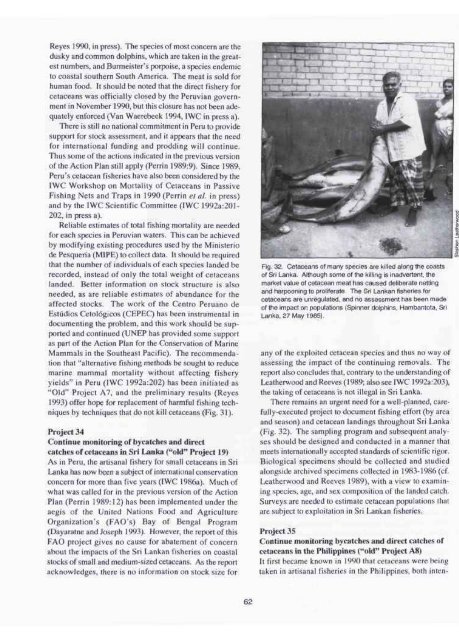Dolphins, Porpoises, and Whales - IUCN
Dolphins, Porpoises, and Whales - IUCN
Dolphins, Porpoises, and Whales - IUCN
You also want an ePaper? Increase the reach of your titles
YUMPU automatically turns print PDFs into web optimized ePapers that Google loves.
Reyes 1990, in press). The species of most concern are the<br />
dusky <strong>and</strong> common dolphins, which are taken in the greatest<br />
numbers, <strong>and</strong> Burmeister's porpoise, a species endemic<br />
to coastal southern South America. The meat is sold for<br />
human food. It should be noted that the direct fishery for<br />
cetaceans was officially closed by the Peruvian government<br />
in November 1990, but this closure has not been adequately<br />
enforced (Van Waerebeek 1994, IWC in press a).<br />
There is still no national commitment in Peru to provide<br />
support for stock assessment, <strong>and</strong> it appears that the need<br />
for international funding <strong>and</strong> prodding will continue.<br />
Thus some of the actions indicated in the previous version<br />
of the Action Plan still apply (Perrin 1989:9). Since 1989,<br />
Peru's cetacean fisheries have also been considered by the<br />
IWC Workshop on Mortality of Cetaceans in Passive<br />
Fishing Nets <strong>and</strong> Traps in 1990 (Perrin et al. in press)<br />
<strong>and</strong> by the IWC Scientific Committee (IWC 1992a:201-<br />
202, in press a).<br />
Reliable estimates of total fishing mortality are needed<br />
for each species in Peruvian waters. This can be achieved<br />
by modifying existing procedures used by the Ministerio<br />
de Pesqueria (MIPE) to collect data. It should be required<br />
that the number of individuals of each species l<strong>and</strong>ed be<br />
recorded, instead of only the total weight of cetaceans<br />
l<strong>and</strong>ed. Better information on stock structure is also<br />
needed, as are reliable estimates of abundance for the<br />
affected stocks. The work of the Centro Peruano de<br />
Estudios Cetologicos (CEPEC) has been instrumental in<br />
documenting the problem, <strong>and</strong> this work should be supported<br />
<strong>and</strong> continued (UNEP has provided some support<br />
as part of the Action Plan for the Conservation of Marine<br />
Mammals in the Southeast Pacific). The recommendation<br />
that "alternative fishing methods be sought to reduce<br />
marine mammal mortality without affecting fishery<br />
yields" in Peru (IWC 1992a:202) has been initialed as<br />
"Old" Project A7, <strong>and</strong> the preliminary results (Reyes<br />
1993) offer hope for replacement of harmful fishing techniques<br />
by techniques that do not kill cetaceans (Fig. 31).<br />
Project 34<br />
Continue monitoring of bycatches <strong>and</strong> direct<br />
catches of cetaceans in Sri Lanka ("old" Project 19)<br />
As in Peru, the artisanal fishery for small cetaceans in Sri<br />
Lanka has now been a subject of international conservation<br />
concern for more than five years (IWC 1986a). Much of<br />
what was called for in the previous version of the Action<br />
Plan (Perrin 1989:12) has been implemented under the<br />
aegis of the United Nations Food <strong>and</strong> Agriculture<br />
Organization's (FAO's) Bay of Bengal Program<br />
(Dayaratne <strong>and</strong> Joseph 1993). However, the report of this<br />
FAO project gives no cause for abatement of concern<br />
about the impacts of the Sri Lankan fisheries on coastal<br />
stocks of small <strong>and</strong> medium-sized cetaceans. As the report<br />
acknowledges, there is no information on stock size for<br />
62<br />
Fig. 32. Cetaceans of many species are killed along the coasts<br />
of Sri Lanka. Although some of the killing is inadvertent, the<br />
market value of cetacean meat has caused deliberate netting<br />
<strong>and</strong> harpooning to proliferate. The Sri Lankan fisheries for<br />
cetaceans are unregulated, <strong>and</strong> no assessment has been made<br />
of the impact on populations (Spinner dolphins, Hambantota, Sri<br />
Lanka, 27 May 1985).<br />
any of the exploited cetacean species <strong>and</strong> thus no way of<br />
assessing the impact of the continuing removals. The<br />
report also concludes that, contrary to the underst<strong>and</strong>ing of<br />
Leatherwood <strong>and</strong> Reeves (1989; also see IWC 1992a:203),<br />
the taking of cetaceans is not illegal in Sri Lanka.<br />
There remains an urgent need for a well-planned, carefully-executed<br />
project to document fishing effort (by area<br />
<strong>and</strong> season) <strong>and</strong> cetacean l<strong>and</strong>ings throughout Sri Lanka<br />
(Fig. 32). The sampling program <strong>and</strong> subsequent analyses<br />
should be designed <strong>and</strong> conducted in a manner that<br />
meets internationally accepted st<strong>and</strong>ards of scientific rigor.<br />
Biological specimens should be collected <strong>and</strong> studied<br />
alongside archived specimens collected in 1983-1986 (cf.<br />
Leatherwood <strong>and</strong> Reeves 1989), with a view to examining<br />
species, age, <strong>and</strong> sex composition of the l<strong>and</strong>ed catch.<br />
Surveys are needed to estimate cetacean populations that<br />
are subject to exploitation in Sri Lankan fisheries.<br />
Project 35<br />
Continue monitoring bycatches <strong>and</strong> direct catches of<br />
cetaceans in the Philippines ("old" Project A8)<br />
It first became known in 1990 that cetaceans were being<br />
taken in artisanal fisheries in the Philippines, both inten-

















